Managing for Quality and Performance Excellence Chapter 3 Summary
VerifiedAdded on 2021/10/27
|6
|1715
|498
Report
AI Summary
This report summarizes Chapter 3 of "Managing for Quality and Performance Excellence," focusing on customer focus as a cornerstone of quality management. It emphasizes the importance of meeting and exceeding customer expectations to achieve long-term competitive success. Key concepts include understanding the voice of the customer, creating a customer-focused culture, measuring customer satisfaction and engagement, and managing customer relationships. The report outlines different dimensions of customer needs, the Kano model for segmenting customer requirements, and various methods for gathering customer feedback. It also explores the linkage between customer expectations and perceived quality, highlighting the importance of service recovery and complaint management. Furthermore, it covers customer relationship management, the use of technology, and the measurement of customer loyalty through metrics like the Net Promoter Score (NPS) and Customer Perceived Value (CPV). The summary highlights the importance of actionable customer satisfaction measurement and the use of importance/performance grids to target areas for improvement, ultimately advocating for a customer-centric approach to drive business success.
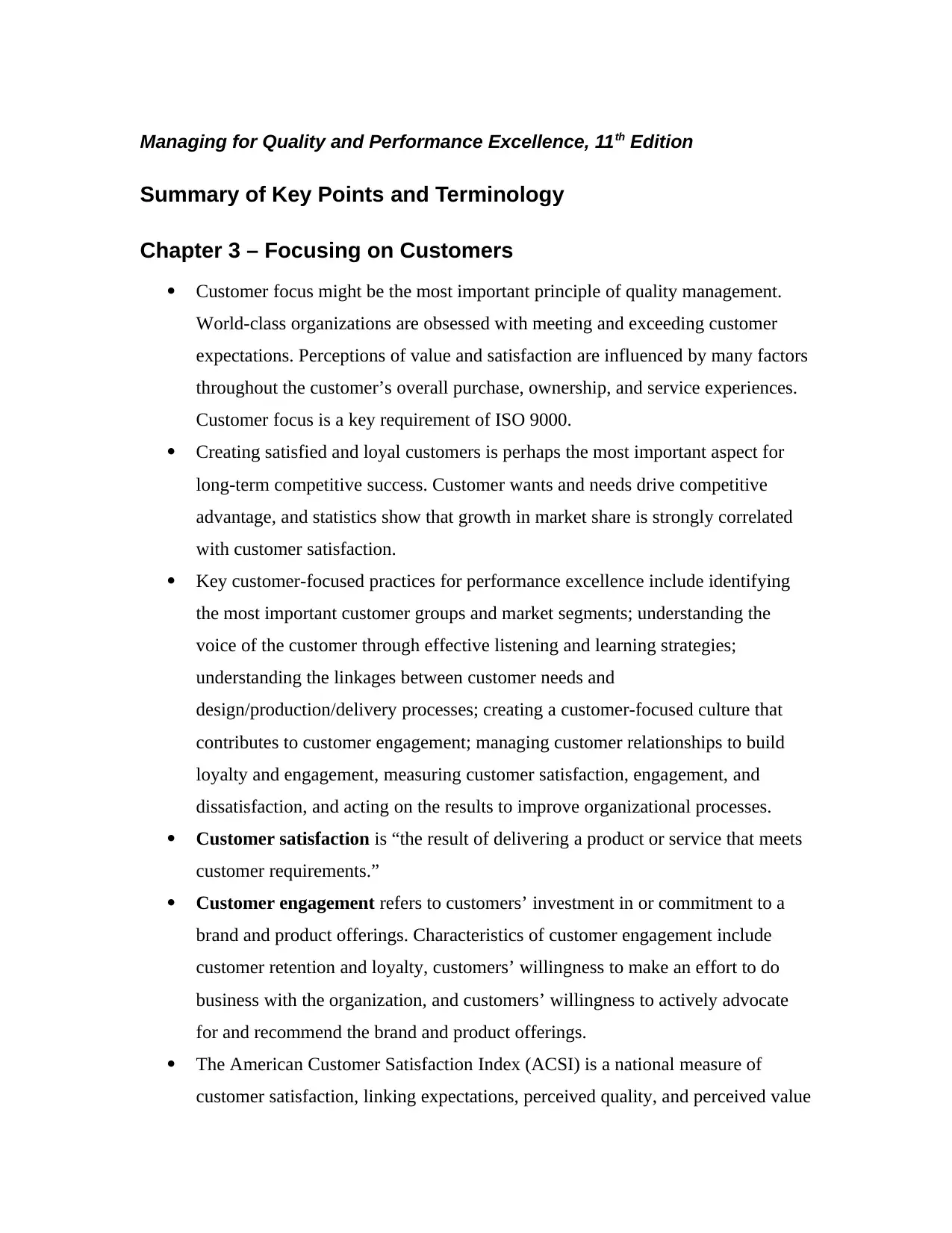
Managing for Quality and Performance Excellence, 11th Edition
Summary of Key Points and Terminology
Chapter 3 – Focusing on Customers
Customer focus might be the most important principle of quality management.
World-class organizations are obsessed with meeting and exceeding customer
expectations. Perceptions of value and satisfaction are influenced by many factors
throughout the customer’s overall purchase, ownership, and service experiences.
Customer focus is a key requirement of ISO 9000.
Creating satisfied and loyal customers is perhaps the most important aspect for
long-term competitive success. Customer wants and needs drive competitive
advantage, and statistics show that growth in market share is strongly correlated
with customer satisfaction.
Key customer-focused practices for performance excellence include identifying
the most important customer groups and market segments; understanding the
voice of the customer through effective listening and learning strategies;
understanding the linkages between customer needs and
design/production/delivery processes; creating a customer-focused culture that
contributes to customer engagement; managing customer relationships to build
loyalty and engagement, measuring customer satisfaction, engagement, and
dissatisfaction, and acting on the results to improve organizational processes.
Customer satisfaction is “the result of delivering a product or service that meets
customer requirements.”
Customer engagement refers to customers’ investment in or commitment to a
brand and product offerings. Characteristics of customer engagement include
customer retention and loyalty, customers’ willingness to make an effort to do
business with the organization, and customers’ willingness to actively advocate
for and recommend the brand and product offerings.
The American Customer Satisfaction Index (ACSI) is a national measure of
customer satisfaction, linking expectations, perceived quality, and perceived value
Summary of Key Points and Terminology
Chapter 3 – Focusing on Customers
Customer focus might be the most important principle of quality management.
World-class organizations are obsessed with meeting and exceeding customer
expectations. Perceptions of value and satisfaction are influenced by many factors
throughout the customer’s overall purchase, ownership, and service experiences.
Customer focus is a key requirement of ISO 9000.
Creating satisfied and loyal customers is perhaps the most important aspect for
long-term competitive success. Customer wants and needs drive competitive
advantage, and statistics show that growth in market share is strongly correlated
with customer satisfaction.
Key customer-focused practices for performance excellence include identifying
the most important customer groups and market segments; understanding the
voice of the customer through effective listening and learning strategies;
understanding the linkages between customer needs and
design/production/delivery processes; creating a customer-focused culture that
contributes to customer engagement; managing customer relationships to build
loyalty and engagement, measuring customer satisfaction, engagement, and
dissatisfaction, and acting on the results to improve organizational processes.
Customer satisfaction is “the result of delivering a product or service that meets
customer requirements.”
Customer engagement refers to customers’ investment in or commitment to a
brand and product offerings. Characteristics of customer engagement include
customer retention and loyalty, customers’ willingness to make an effort to do
business with the organization, and customers’ willingness to actively advocate
for and recommend the brand and product offerings.
The American Customer Satisfaction Index (ACSI) is a national measure of
customer satisfaction, linking expectations, perceived quality, and perceived value
Paraphrase This Document
Need a fresh take? Get an instant paraphrase of this document with our AI Paraphraser
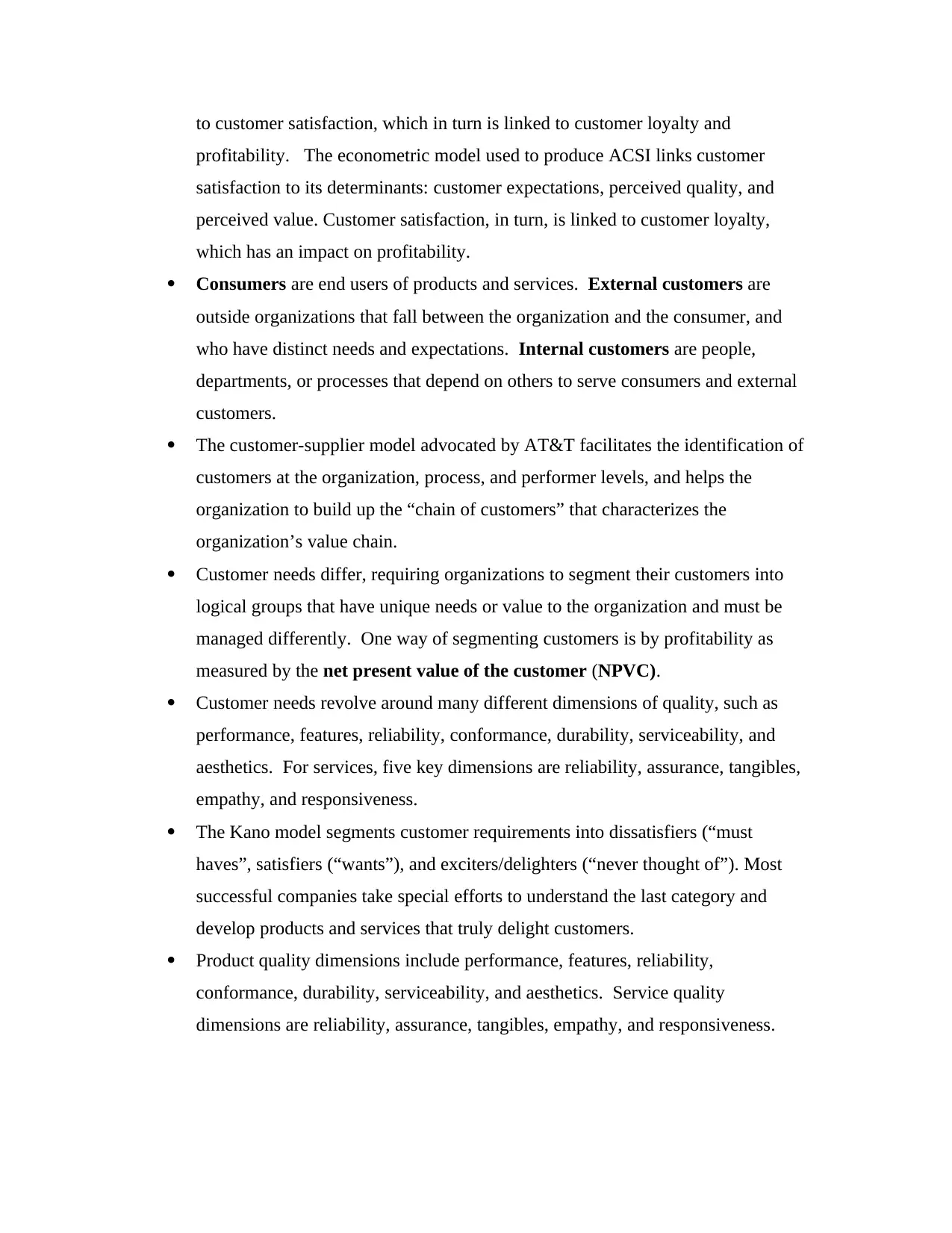
to customer satisfaction, which in turn is linked to customer loyalty and
profitability. The econometric model used to produce ACSI links customer
satisfaction to its determinants: customer expectations, perceived quality, and
perceived value. Customer satisfaction, in turn, is linked to customer loyalty,
which has an impact on profitability.
Consumers are end users of products and services. External customers are
outside organizations that fall between the organization and the consumer, and
who have distinct needs and expectations. Internal customers are people,
departments, or processes that depend on others to serve consumers and external
customers.
The customer-supplier model advocated by AT&T facilitates the identification of
customers at the organization, process, and performer levels, and helps the
organization to build up the “chain of customers” that characterizes the
organization’s value chain.
Customer needs differ, requiring organizations to segment their customers into
logical groups that have unique needs or value to the organization and must be
managed differently. One way of segmenting customers is by profitability as
measured by the net present value of the customer (NPVC).
Customer needs revolve around many different dimensions of quality, such as
performance, features, reliability, conformance, durability, serviceability, and
aesthetics. For services, five key dimensions are reliability, assurance, tangibles,
empathy, and responsiveness.
The Kano model segments customer requirements into dissatisfiers (“must
haves”, satisfiers (“wants”), and exciters/delighters (“never thought of”). Most
successful companies take special efforts to understand the last category and
develop products and services that truly delight customers.
Product quality dimensions include performance, features, reliability,
conformance, durability, serviceability, and aesthetics. Service quality
dimensions are reliability, assurance, tangibles, empathy, and responsiveness.
profitability. The econometric model used to produce ACSI links customer
satisfaction to its determinants: customer expectations, perceived quality, and
perceived value. Customer satisfaction, in turn, is linked to customer loyalty,
which has an impact on profitability.
Consumers are end users of products and services. External customers are
outside organizations that fall between the organization and the consumer, and
who have distinct needs and expectations. Internal customers are people,
departments, or processes that depend on others to serve consumers and external
customers.
The customer-supplier model advocated by AT&T facilitates the identification of
customers at the organization, process, and performer levels, and helps the
organization to build up the “chain of customers” that characterizes the
organization’s value chain.
Customer needs differ, requiring organizations to segment their customers into
logical groups that have unique needs or value to the organization and must be
managed differently. One way of segmenting customers is by profitability as
measured by the net present value of the customer (NPVC).
Customer needs revolve around many different dimensions of quality, such as
performance, features, reliability, conformance, durability, serviceability, and
aesthetics. For services, five key dimensions are reliability, assurance, tangibles,
empathy, and responsiveness.
The Kano model segments customer requirements into dissatisfiers (“must
haves”, satisfiers (“wants”), and exciters/delighters (“never thought of”). Most
successful companies take special efforts to understand the last category and
develop products and services that truly delight customers.
Product quality dimensions include performance, features, reliability,
conformance, durability, serviceability, and aesthetics. Service quality
dimensions are reliability, assurance, tangibles, empathy, and responsiveness.
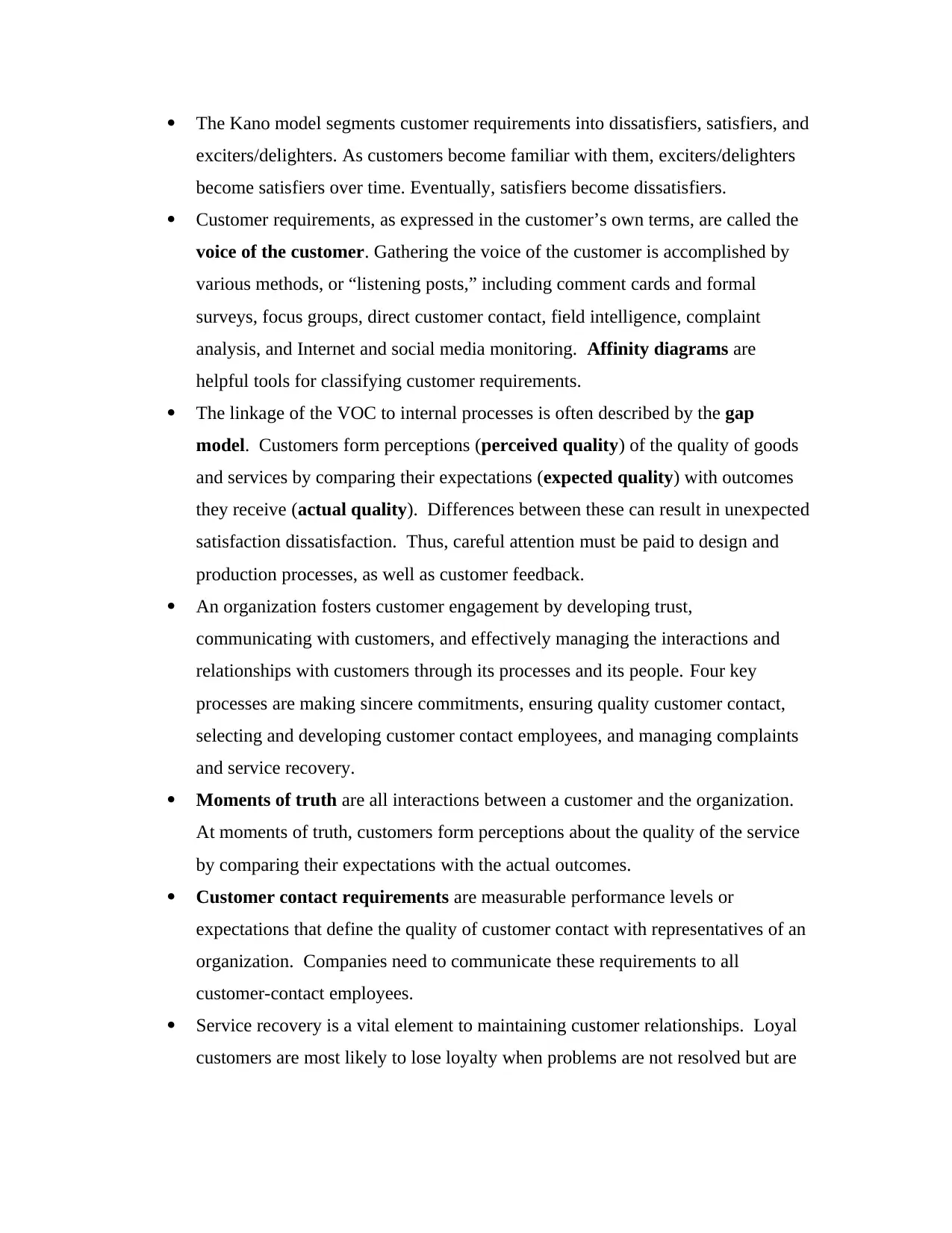
The Kano model segments customer requirements into dissatisfiers, satisfiers, and
exciters/delighters. As customers become familiar with them, exciters/delighters
become satisfiers over time. Eventually, satisfiers become dissatisfiers.
Customer requirements, as expressed in the customer’s own terms, are called the
voice of the customer. Gathering the voice of the customer is accomplished by
various methods, or “listening posts,” including comment cards and formal
surveys, focus groups, direct customer contact, field intelligence, complaint
analysis, and Internet and social media monitoring. Affinity diagrams are
helpful tools for classifying customer requirements.
The linkage of the VOC to internal processes is often described by the gap
model. Customers form perceptions (perceived quality) of the quality of goods
and services by comparing their expectations (expected quality) with outcomes
they receive (actual quality). Differences between these can result in unexpected
satisfaction dissatisfaction. Thus, careful attention must be paid to design and
production processes, as well as customer feedback.
An organization fosters customer engagement by developing trust,
communicating with customers, and effectively managing the interactions and
relationships with customers through its processes and its people. Four key
processes are making sincere commitments, ensuring quality customer contact,
selecting and developing customer contact employees, and managing complaints
and service recovery.
Moments of truth are all interactions between a customer and the organization.
At moments of truth, customers form perceptions about the quality of the service
by comparing their expectations with the actual outcomes.
Customer contact requirements are measurable performance levels or
expectations that define the quality of customer contact with representatives of an
organization. Companies need to communicate these requirements to all
customer-contact employees.
Service recovery is a vital element to maintaining customer relationships. Loyal
customers are most likely to lose loyalty when problems are not resolved but are
exciters/delighters. As customers become familiar with them, exciters/delighters
become satisfiers over time. Eventually, satisfiers become dissatisfiers.
Customer requirements, as expressed in the customer’s own terms, are called the
voice of the customer. Gathering the voice of the customer is accomplished by
various methods, or “listening posts,” including comment cards and formal
surveys, focus groups, direct customer contact, field intelligence, complaint
analysis, and Internet and social media monitoring. Affinity diagrams are
helpful tools for classifying customer requirements.
The linkage of the VOC to internal processes is often described by the gap
model. Customers form perceptions (perceived quality) of the quality of goods
and services by comparing their expectations (expected quality) with outcomes
they receive (actual quality). Differences between these can result in unexpected
satisfaction dissatisfaction. Thus, careful attention must be paid to design and
production processes, as well as customer feedback.
An organization fosters customer engagement by developing trust,
communicating with customers, and effectively managing the interactions and
relationships with customers through its processes and its people. Four key
processes are making sincere commitments, ensuring quality customer contact,
selecting and developing customer contact employees, and managing complaints
and service recovery.
Moments of truth are all interactions between a customer and the organization.
At moments of truth, customers form perceptions about the quality of the service
by comparing their expectations with the actual outcomes.
Customer contact requirements are measurable performance levels or
expectations that define the quality of customer contact with representatives of an
organization. Companies need to communicate these requirements to all
customer-contact employees.
Service recovery is a vital element to maintaining customer relationships. Loyal
customers are most likely to lose loyalty when problems are not resolved but are
⊘ This is a preview!⊘
Do you want full access?
Subscribe today to unlock all pages.

Trusted by 1+ million students worldwide
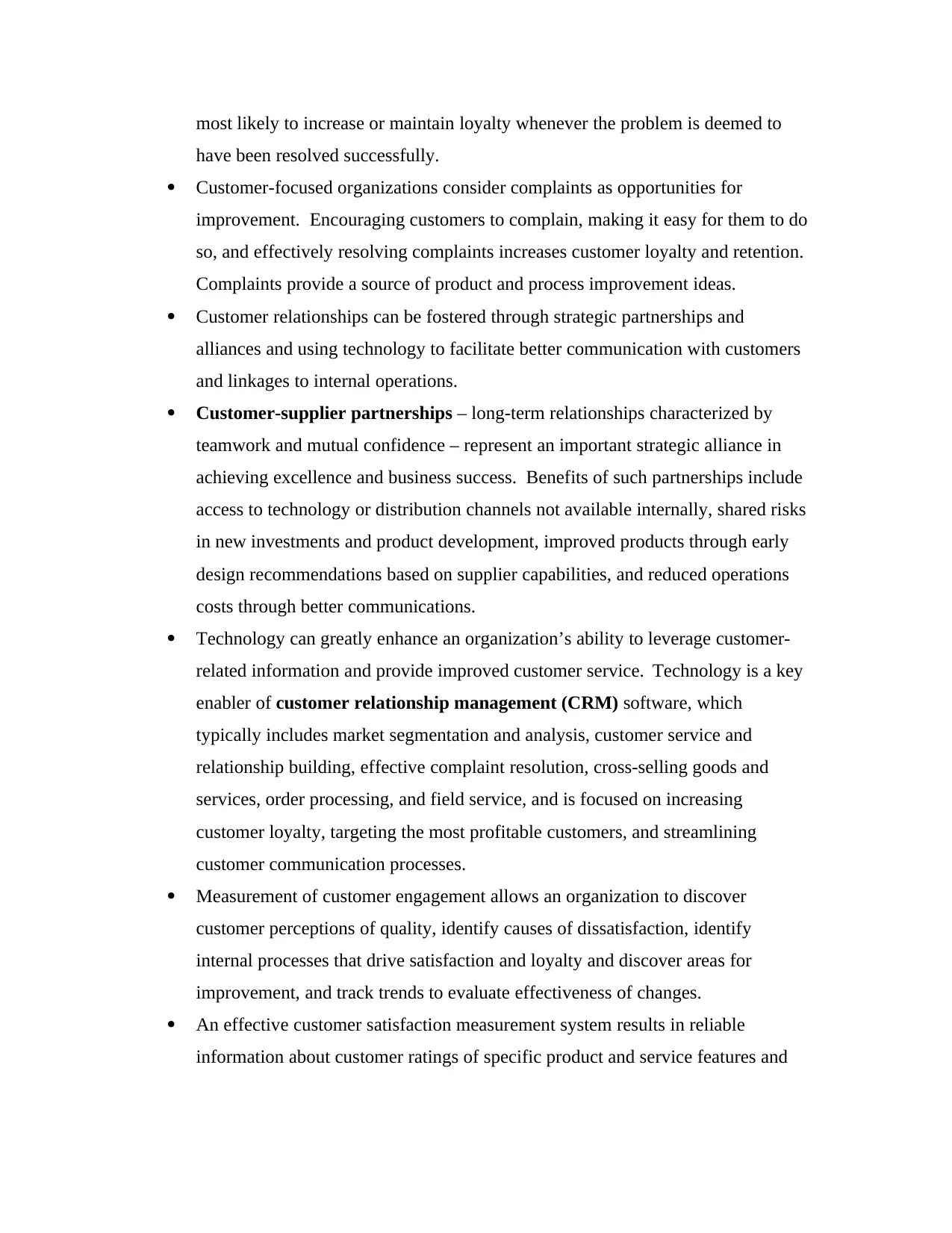
most likely to increase or maintain loyalty whenever the problem is deemed to
have been resolved successfully.
Customer-focused organizations consider complaints as opportunities for
improvement. Encouraging customers to complain, making it easy for them to do
so, and effectively resolving complaints increases customer loyalty and retention.
Complaints provide a source of product and process improvement ideas.
Customer relationships can be fostered through strategic partnerships and
alliances and using technology to facilitate better communication with customers
and linkages to internal operations.
Customer-supplier partnerships – long-term relationships characterized by
teamwork and mutual confidence – represent an important strategic alliance in
achieving excellence and business success. Benefits of such partnerships include
access to technology or distribution channels not available internally, shared risks
in new investments and product development, improved products through early
design recommendations based on supplier capabilities, and reduced operations
costs through better communications.
Technology can greatly enhance an organization’s ability to leverage customer-
related information and provide improved customer service. Technology is a key
enabler of customer relationship management (CRM) software, which
typically includes market segmentation and analysis, customer service and
relationship building, effective complaint resolution, cross-selling goods and
services, order processing, and field service, and is focused on increasing
customer loyalty, targeting the most profitable customers, and streamlining
customer communication processes.
Measurement of customer engagement allows an organization to discover
customer perceptions of quality, identify causes of dissatisfaction, identify
internal processes that drive satisfaction and loyalty and discover areas for
improvement, and track trends to evaluate effectiveness of changes.
An effective customer satisfaction measurement system results in reliable
information about customer ratings of specific product and service features and
have been resolved successfully.
Customer-focused organizations consider complaints as opportunities for
improvement. Encouraging customers to complain, making it easy for them to do
so, and effectively resolving complaints increases customer loyalty and retention.
Complaints provide a source of product and process improvement ideas.
Customer relationships can be fostered through strategic partnerships and
alliances and using technology to facilitate better communication with customers
and linkages to internal operations.
Customer-supplier partnerships – long-term relationships characterized by
teamwork and mutual confidence – represent an important strategic alliance in
achieving excellence and business success. Benefits of such partnerships include
access to technology or distribution channels not available internally, shared risks
in new investments and product development, improved products through early
design recommendations based on supplier capabilities, and reduced operations
costs through better communications.
Technology can greatly enhance an organization’s ability to leverage customer-
related information and provide improved customer service. Technology is a key
enabler of customer relationship management (CRM) software, which
typically includes market segmentation and analysis, customer service and
relationship building, effective complaint resolution, cross-selling goods and
services, order processing, and field service, and is focused on increasing
customer loyalty, targeting the most profitable customers, and streamlining
customer communication processes.
Measurement of customer engagement allows an organization to discover
customer perceptions of quality, identify causes of dissatisfaction, identify
internal processes that drive satisfaction and loyalty and discover areas for
improvement, and track trends to evaluate effectiveness of changes.
An effective customer satisfaction measurement system results in reliable
information about customer ratings of specific product and service features and
Paraphrase This Document
Need a fresh take? Get an instant paraphrase of this document with our AI Paraphraser
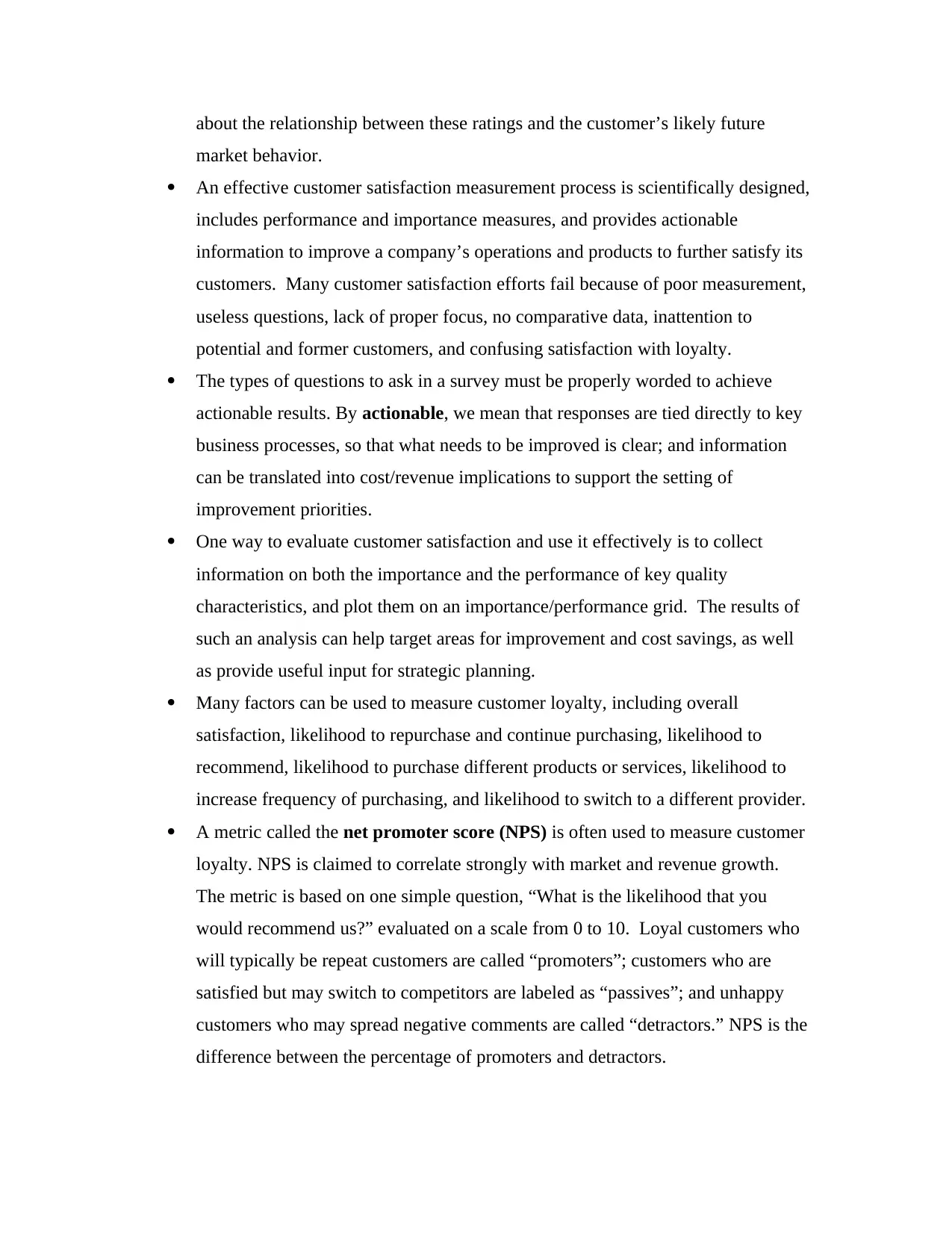
about the relationship between these ratings and the customer’s likely future
market behavior.
An effective customer satisfaction measurement process is scientifically designed,
includes performance and importance measures, and provides actionable
information to improve a company’s operations and products to further satisfy its
customers. Many customer satisfaction efforts fail because of poor measurement,
useless questions, lack of proper focus, no comparative data, inattention to
potential and former customers, and confusing satisfaction with loyalty.
The types of questions to ask in a survey must be properly worded to achieve
actionable results. By actionable, we mean that responses are tied directly to key
business processes, so that what needs to be improved is clear; and information
can be translated into cost/revenue implications to support the setting of
improvement priorities.
One way to evaluate customer satisfaction and use it effectively is to collect
information on both the importance and the performance of key quality
characteristics, and plot them on an importance/performance grid. The results of
such an analysis can help target areas for improvement and cost savings, as well
as provide useful input for strategic planning.
Many factors can be used to measure customer loyalty, including overall
satisfaction, likelihood to repurchase and continue purchasing, likelihood to
recommend, likelihood to purchase different products or services, likelihood to
increase frequency of purchasing, and likelihood to switch to a different provider.
A metric called the net promoter score (NPS) is often used to measure customer
loyalty. NPS is claimed to correlate strongly with market and revenue growth.
The metric is based on one simple question, “What is the likelihood that you
would recommend us?” evaluated on a scale from 0 to 10. Loyal customers who
will typically be repeat customers are called “promoters”; customers who are
satisfied but may switch to competitors are labeled as “passives”; and unhappy
customers who may spread negative comments are called “detractors.” NPS is the
difference between the percentage of promoters and detractors.
market behavior.
An effective customer satisfaction measurement process is scientifically designed,
includes performance and importance measures, and provides actionable
information to improve a company’s operations and products to further satisfy its
customers. Many customer satisfaction efforts fail because of poor measurement,
useless questions, lack of proper focus, no comparative data, inattention to
potential and former customers, and confusing satisfaction with loyalty.
The types of questions to ask in a survey must be properly worded to achieve
actionable results. By actionable, we mean that responses are tied directly to key
business processes, so that what needs to be improved is clear; and information
can be translated into cost/revenue implications to support the setting of
improvement priorities.
One way to evaluate customer satisfaction and use it effectively is to collect
information on both the importance and the performance of key quality
characteristics, and plot them on an importance/performance grid. The results of
such an analysis can help target areas for improvement and cost savings, as well
as provide useful input for strategic planning.
Many factors can be used to measure customer loyalty, including overall
satisfaction, likelihood to repurchase and continue purchasing, likelihood to
recommend, likelihood to purchase different products or services, likelihood to
increase frequency of purchasing, and likelihood to switch to a different provider.
A metric called the net promoter score (NPS) is often used to measure customer
loyalty. NPS is claimed to correlate strongly with market and revenue growth.
The metric is based on one simple question, “What is the likelihood that you
would recommend us?” evaluated on a scale from 0 to 10. Loyal customers who
will typically be repeat customers are called “promoters”; customers who are
satisfied but may switch to competitors are labeled as “passives”; and unhappy
customers who may spread negative comments are called “detractors.” NPS is the
difference between the percentage of promoters and detractors.
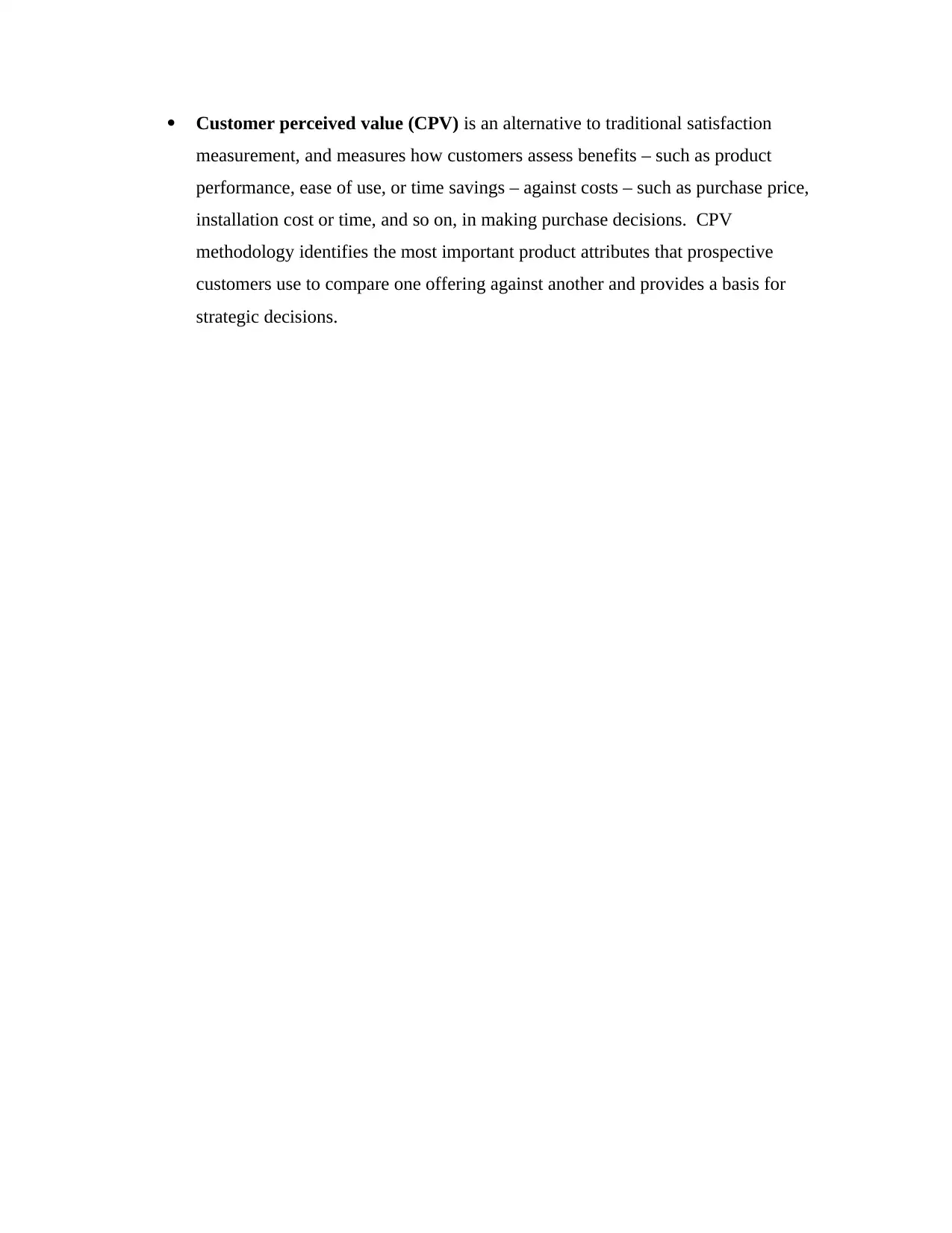
Customer perceived value (CPV) is an alternative to traditional satisfaction
measurement, and measures how customers assess benefits – such as product
performance, ease of use, or time savings – against costs – such as purchase price,
installation cost or time, and so on, in making purchase decisions. CPV
methodology identifies the most important product attributes that prospective
customers use to compare one offering against another and provides a basis for
strategic decisions.
measurement, and measures how customers assess benefits – such as product
performance, ease of use, or time savings – against costs – such as purchase price,
installation cost or time, and so on, in making purchase decisions. CPV
methodology identifies the most important product attributes that prospective
customers use to compare one offering against another and provides a basis for
strategic decisions.
⊘ This is a preview!⊘
Do you want full access?
Subscribe today to unlock all pages.

Trusted by 1+ million students worldwide
1 out of 6
Related Documents
Your All-in-One AI-Powered Toolkit for Academic Success.
+13062052269
info@desklib.com
Available 24*7 on WhatsApp / Email
![[object Object]](/_next/static/media/star-bottom.7253800d.svg)
Unlock your academic potential
Copyright © 2020–2025 A2Z Services. All Rights Reserved. Developed and managed by ZUCOL.





